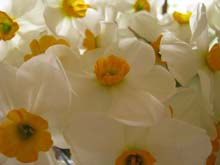My favorite Narcissus is a small, tazetta type called 'Geranium', shown in photo below. I planted it 10 years ago and although the field where it grows was long ago turned over to grass, this daffodil comes back every year, always increasing in abundance. It has clusters of three or more small, cream-colored flowers on each stem. It's not very tall, about 12 inches, but what it lacks in stem length it makes up for with fragrance. A few dozen of these will perfume the entire house.

If you're interested in growing daffodils, it's helpful to know the classification system used to describe them. According to the American Daffodil Society, there is no difference between narcissus and daffodils. Narcissus is the botanical name, and daffodil is the common name. The American Daffodil Society encourages people to use the word daffodil, though I can't imagine why. Narcissus is so much more beautiful. There are 25 species of Narcissus with more than 13,000 hybrids. They are divided into 12 divisions, based primarily on their flower shape. The most famous daffodil division is probably the Trumpet, which has a cup larger than the petals. I don't grow those, because they are so commonly available in supermarkets around the same time mine are blooming. Another division is the Doubles, which I have grown but abandoned because they are too top-heavy and end up in the mud after a rainfall. The Poeticus have pure white petals and red-rimmed coronas. For a complete description of the Narcissus divisions, click here.
Daffodils never bring in much money on a flower farm, but I have never regretted planting them. They serve a purpose -- getting me excited about the season ahead, and making me remember why I became a flower farmer!
